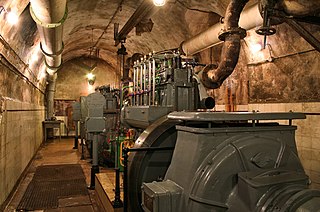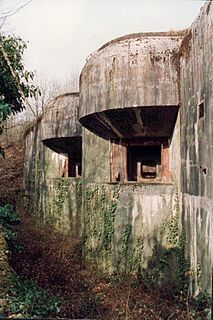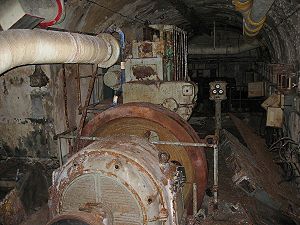
Ouvrage du Kobenbusch is a gros ouvrage of the Maginot Line, located in the Fortified Sector of Thionville in the Cattenom Forest. It possesses seven combat blocks and two entrance blocks, one for ammunition and the other for men. It is located between petit ouvrage Bois-Karre and petit ouvrage Oberheid, and was named for the surrounding Kobenbusch Forest.

Ouvrage Hackenberg, one of the largest of the Maginot Line fortifications, is part of the Fortified Sector of Boulay. It is situated twenty kilometres east of Thionville, in the Moselle département, near the village of Veckring, on the Hackenberg. It is located between gros ouvrage Billig and petit ouvrage Coucou, facing Germany. The fort occupies the wooded Hackenberg ridge. Before World War II it was considered a showpiece of French fortification technology, and was visited by British King George VI.

Ouvrage Mont des Welches, a gros ouvrage of the Maginot Line fortifications, is part of the Fortified Sector of Boulay. It comprises two entrance blocks, one infantry block, one artillery block, one observation block and two combination blocks. It is located between petit ouvrage Coucou and gros ouvrage Michelsberg, facing Germany. Relatively small for a gros ouvrage, Mont des Welches saw a brief period of sharp action in June 1940, when German forces moving along the rear of the Maginot Line engaged the position without success. After modest renovations in the 1950s, Mont des Welches was abandoned in the 1970s.

Ouvrage Michelsberg, one of the Maginot Line fortifications, formed part of the Fortified Sector of Boulay as well as the fortified region of Metz. The ouvrage is located in Moselle (département) between the towns of Dalstein and d'Ebersviller, about 23 km from Thionville. It is located between gros ouvrage Mont des Welches and petit ouvrage Hobling, facing Germany. Michelsberg did not see significant action in the Battle of France until June 1940, when it was attacked from the rear by German forces that had bypassed the Maginot Line. It successfully resisted these attacks, but was compelled to surrender in accordance with the 25 June 1940 armistice. After the Second World War it was renovated as a Cold War fortification against a potential Soviet invasion, then abandoned. It is now operated as a museum, and may be visited.

Ouvrage Coucou is a lesser work of the Maginot Line, located in the Fortified Sector of Boulay. The ouvrage consists of two infantry blocks, and is located between the gros ouvrages of Hackenberg and Mont des Welches, facing Germany, just north of Kemplich.

Ouvrage Hobling is a lesser work of the Maginot Line. Located in the Fortified Sector of Boulay, the ouvrage consists of two infantry blocks and two observation blocks, and is located between gros ouvrage Michelsberg and petit ouvrage Bousse, facing Germany. It has been stripped of metals and abandoned.

Ouvrage Bousse, also known as Ouvrage Bois de Bousse, is a lesser work of the Maginot Line in the Fortified Sector of Boulay. The ouvrage is located between petit ouvrage Hobling and gros ouvrage Anzeling, near Hestroff in the Bois du Bousse, facing Germany. A small position, it was manned primarily by reservists. It is noted for the events of 15 June 1940, when it received orders to prepare for an evacuation as German forces advanced along the Line in the Battle of France. As the garrison prepared to abandon the position, sabotaging equipment, they destroyed their telephone connection, leaving them unable to receive the order countermanding the evacuation. The garrison was captured three days after leaving Bousse. Bousse is now managed as a museum and is open to public visitation.

Ouvrage Bovenberg is a lesser work of the Maginot Line. Located in the Fortified Sector of Boulay, the ouvrage is located between petits ouvrages Berenbach and Denting, facing Germany. It consists of two infantry blocks and two artillery blocks.

Ouvrage Billig, a gros ouvrage or large fortification of the Maginot Line, was located in the Fortified Sector of Thionville, Moselle in northern France. It is located between the gros ouvrages Metrich and Hackenberg, facing Germany. It saw relatively little action during World War II and after a period of reserve duty in the 1950s, was abandoned in the 1970s.

Ouvrage Métrich located in the village of Kœnigsmacker in Moselle, comprises part of the Elzange portion of the Fortified Sector of Thionville of the Maginot Line. A gros ouvrage, it is the third largest of the Line, after Hackenberg and Hochwald. It lies between petit ouvrage Sentzich and gros ouvrage Billig, facing Germany. Located to the east of the Moselle, it cooperated with Ouvrage Galgenberg to control the river valley.

Ouvrage Rochonvillers is one of the largest of the Maginot Line fortifications. Located above the town of Rochonvillers in the French region of Lorraine, the gros ouvrage or large work was fully equipped and occupied in 1935 as part of the Fortified Sector of Thionville in the Moselle. It is located between the petit ouvrage d'Aumetz and the gros ouvrage Molvange, facing the border between Luxembourg and France with nine combat blocks. Rochonvillers saw little action during World War II, but due to its size it was repaired and retained in service after the war. During the Cold War it found a new use as a hardened military command center, first for NATO and then for the French Army.

Ouvrage Molvange is a large work, or gros ouvrage of the Maginot Line. The fortification complex faces the France-Luxembourg border from a height near Entrange in the Moselle département. The complex, armed and occupied in 1935, is located on the heights of Entrange, at an altitude of about 400 meters (1,300 ft). Molvange is flanked by the even larger Ouvrage Rochonvillers to the west and smaller petit ouvrage Immerhof to the east, part of the Fortified Sector of Thionville. Molvange was not involved in significant combat during World War II, but due to its size it was repaired and retained in service after the war. During the Cold War Molvange's underground barracks and former ammunition magazine became a hardened military command center.

Ouvrage Aumetz is a small work, or petit ouvrage of the Maginot Line. It is part of the Fortified Sector of the Crusnes and is located near the community of Aumetz in the Moselle département of France. The petit ouvrage flanked by the gros ouvrages Bréhain and Rochonvillers, all facing the France-Luxembourg border. Aumetz was initially planned as a gros ouvrage of six combat blocks, but only three infantry blocks were built. Aumetz saw limited action during the Battle of France. In the 1970s it was the first Maginot position to be offered for sale to the public.

Ouvrage Immerhof, also known as Ouvrage Ferme-Immerhof, is one of the largest petit ouvrages of the Maginot Line of northeast France. Located near the community of Hettange-Grande, it is 7 km north of Thionville between the gros ouvrages of Molvange and Soetrich, the closest ouvrage to the Luxembourg frontier. It was part of the Fortified Sector of Thionville, in the Fortified Region of Metz, the strongest portion of the Line. Apart from its function as a communication post between the neighbouring gros ouvrages, Immerhof also controlled the road and railway routes from Luxembourg, which pass in the immediate vicinity. In addition, Immerhof protected other Maginot works in the vicinity: the casemates of Kanfen, the infantry shelter of Stressling, the observation point and shelter of Hettange-Grande, and a number of nearby blockhouses constructed during the Phoney War.

Ouvrage Bois- Karre is located in the Fortified Sector of Thionville of the Maginot Line, facing the France - Luxembourg border. The petit ouvrage is situated in the Cattenom Forest between the gros ouvrages Soetrich and Kobenbusch, just south of Boust. It is unusual for a Maginot fortification in its construction as a single blockhouse, with no underground gallery system or remotely located entries. Bois-Karre has been preserved and is maintained as a museum.

Ouvrage Galgenberg forms a portion of the Fortified Sector of Thionville of the Maginot Line. It is situated in the Cattenom Forest, near the gros ouvrage Kobenbusch and petit ouvrage Oberheid. The ouvrage was tasked with controlling the Moselle valley and as such was called the "Guardian of the Moselle." Galgenberg did not see significant action in 1940 or 1944. After a period of reserve duty in the 1950s and 1960s it was deactivated. It is now a museum.

Ouvrage Otterbiel forms part of the Maginot Line in the Fortified Sector of Rohrbach, Sub-sector of Bitche, and is located on the Camp de Bitche of the French Army. It is located between gros ouvrage Schiesseck and petit ouvrage Grand Hohekirkel. Part of the Fortified Sector of Rohrbach, the petit ouvrage comprises four combat blocks and an entry block. Due to budget restrictions, a planned flanking infantry block was never constructed. Otterbiel saw no significant action in the Battle of France, and limited action during the 1944/45 Lorraine Campaign. It was renovated for use during the Cold War. Otterbiel is used for ammunition storage by the French Army.

Ouvrage Simserhof is a gros ouvrage of the Maginot Line, located in the French commune of Siersthal in the Moselle department. It faces the German border and is adjoined by the petit ouvrage Rohrbach and the gros ouvrage Schiesseck. Located 4 km west of Bitche, the ouvrage derived its name from a nearby farm. It was part of the Fortified Sector of Rohrbach. During the Battle of France in 1940, the Simserhof supported its neighboring fortifications with partially successful covering artillery fire. After the surrender of France, it was repurposed by the Germans as a torpedo storage depot, and later resisted the American advances of late 1944. The Americans briefly occupied the fort in the first days of 1945 until the German counter-offensive of Operation Nordwind, which allowed them to take back control of the Simserhof. The fort was finally liberated by the 100th Infantry Division on March 15, 1945. Following the war, it was initially repaired for the French Army and later converted into a Maginot Line museum in the early 1960s. Retained by the Ministry of Defense, Simserhof now functions as a museum, and has the most extensive visitor infrastructure of any of the preserved Maginot fortifications.

Ouvrage Schiesseck is a gros ouvrage of the Maginot Line, located near Bitche in the French département of Moselle. Schiesseck is adjoined by gros ouvrage Simserhof and petit ouvrage Otterbiel, all part of the Fortified Sector of Rohrbach, and faces the German frontier. Schiesseck saw comparatively little activity during the Battle of France, surrendering with other positions in its sector on 30 June 1940. During the Lorraine Campaign of 1944 Schiesseck was occupied by German forces and presented a point of resistance to American advances, requiring heavy bombardment and infantry assaults by engineer units to capture. The area was abandoned during the Battle of the Bulge, but was recaptured in March 1945. In the 1950s Schiesseck was repaired as part of a program to re-arm the Maginot Line against a potential advance by Warsaw Pact forces. It was abandoned in the early 1970s. Schiesseck is on military land and is not visitable by the public.

Ouvrage Grand-Hohékirkel is a petit ouvrage of the Maginot Line, located near Bitche in the French département of Moselle. Grand-Hohékirkel is adjoined by gros ouvrage Otterbiel to the west and petit ouvrage Lembach at some distance to the east, and faces the German frontier. It was part of the Fortified Sector of the Vosges.














